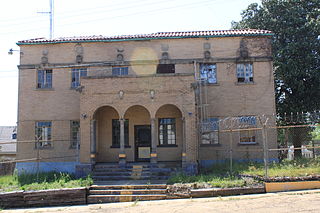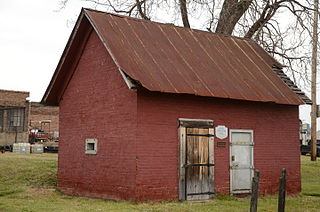
The Delta Cultural Center in downtown Helena, Arkansas, is a cultural center and museum of the Department of Arkansas Heritage. It is dedicated to preserving and interpreting the culture of the Arkansas Delta. They also partner with other cultural organizations to interpret different cultural elements.

The T.G. Richards and Company Store, also known as Whatcom County Courthouse and James B. Steadman Post No. 24, is the first and oldest brick building in the state of Washington, United States, and is listed on the U.S. National Register of Historic Places.
A Mississippi Landmark is a building officially nominated by the Mississippi Department of Archives and History and approved by each county's chancery clerk. The Mississippi Landmark designation is the highest form of recognition bestowed on properties by the state of Mississippi, and designated properties are protected from changes that may alter the property's historic character. Currently there are 890 designated landmarks in the state. Mississippi Landmarks are spread out between eighty-one of Mississippi's eighty-two counties; only Issaquena County has no such landmarks.

City Market is a historic building located in downtown Davenport, Iowa, United States. It was individually listed on the National Register of Historic Places in 1984. In 2020 it was included as a contributing property in the Davenport Downtown Commercial Historic District.

The Boone County Courthouse is a historic courthouse in Harrison, Arkansas. It is a two-story brick structure, designed by noted Arkansas architect Charles L. Thompson and built in 1907. It is Georgian Revival in style, with a hip roof above a course of dentil molding, and bands of cast stone that mark the floor levels of the building. It has a projecting gabled entry section, three bays wide, with brick pilasters separating the center entrance from the flanking windows. The gable end has a dentillated pediment, and has a bullseye window at the center.
The Boone County Jail is a historic jail building at Central Ave. and Willow St. in Harrison, Arkansas. It is a two-story red brick building, built in 1914. Its design has been attributed to prominent Arkansas architect Charles L. Thompson. Its hip roof is finished in red tile, as is the roof of the single-story porch sheltering the main entrance. The jail was laid out to house the jailer on the first floor, and the prisoners on the second.

The Washington County Jail is a historic former civic building at 90 South College Avenue in Fayetteville, Arkansas. Built in 1896, this building was the fourth to serve as county jail, and was in use until 1973, making it the longest tenured in county history. The Romanesque Revival building was designed by W. B. Reese, and is locally unusual and distinctive for its medieval appearance. It is built out of load-bearing stone, square cut and laid in irregular courses, with a rough quarry-cut finish. Most of the building is of darker shades with trim in lighter shades. Nominally two stories in height, the rightmost bay has a square tower with crenellated parapet.

The Mississippi County Courthouse is a courthouse at Poplar Street and Hale Avenue in Osceola, Arkansas, United States, one of two county seats of Mississippi County, built in 1912. It was listed on the National Register of Historic Places in 1978. The courthouse was built in the Classic Revival style by John Gainsford and anchors the Osceola town square.

The Columbia County Jail is a historic structure at Calhoun and Jefferson Streets in Magnolia, Arkansas. The brick two story structure in Umatilla County was designed by Thompson & Harding and was built c. 1920, and is an excellent local example of Italian Renaissance architecture. It is faced in cream-colored brick, and has a terracotta hipped roof. It has an entrance portico with round arches supported by slender columns and gargoyles at its corners.

Powhatan Historic State Park is a 9.1-acre (3.7 ha) Arkansas state park in Lawrence County, Arkansas in the United States. The park contains the 1888 Powhatan courthouse which served as the home of county government from 1869 to 1968. Today the structure displays items of cultural and historical significance and hosts the park's Visitor Center. The park includes four additional historical buildings and the Arkansas History Commission's Northeast Arkansas Regional Archives. A tour of the historic structures is available. Powhatan served as an important stop for traffic on the Black River until the installation of the Kansas City-Memphis Railwayline two miles north in 1883 significantly decreased the need for river transportation.

Hermitage City Hall and Jail is a historic building at 112 South Oak Street in Hermitage, Arkansas. A modest single story yellow brick building probably built in the 1940s, its front section served as Hermitage City Hall, and the rear as the city jail, until 2000.

The Gurdon Jail is a historic city jail at West Joslyn and Front Streets in Gurdon, Arkansas. The single-story brick building, which contains two cells, was built in 1907 by the co-owner of the local brick company, M.D. Lowe. It is the only such structure in the city, and is one of a few surviving buildings from Gurdon's boom time as a lumber town in the early 20th century.

The Old Gillett Jail is a historic former city jail at 207 Main Street in Gillett, Arkansas. It is a single-story brick structure, housing two cells and a small entry vestibule. Its windows have vertical iron bars over them, and the door is made of solid metal. The roof is made of metal. It was built in 1922, and served as the city jail until about 1972.

The Mississippi County Courthouse for the Chickasawba District is located at 200 West Walnut Street in Blytheville, Arkansas, one of Mississippi County's two seats. It is a 3+1⁄2-story brick-and-cut-sandstone structure, designed by the Pine Bluff firm of Selligman and Ellesvard, and built in 1919. It is a fine local example of Colonial Revival styling, with a recessed center entrance and a projecting modillioned cornice. The interior has had few alterations since its construction.
The Old Bell Telephone Building is a historic commercial building at 109 North Ash Street in downtown Osceola, Arkansas. It is a two-story flat-roof brick building, built in 1911 to house the town's telephone exchange. The building is three bays wide, with the door in the right bay, with a transom window above. There is an original brass slot for accepting payments between the doorway and the center window. The building was built by R. C. Rose, a local attorney who owned the telephone exchange.
The Rector Waterworks Building is a historic civic building at 703 South Main Street in Rector, Arkansas. It is a single-story brick building, with a false gabled front masking a flat roof. The front facade is three bays wide, with the outer bays filled with pairs of round-arch windows. The center bay has a slightly recessed double-door entry, with a sheltering gable-roofed portico which is supported by brick piers. The bays are separated by brick pilasters. The building was erected c. 1928 as part of the city's first water supply system. For a period of about 15 years the building also served as the local jail.

The Benton County Jail is a historic county jail building at 212 North Main Street in Bentonville, Arkansas, United States. It is a two-story brick Classical Revival building, designed by A. O. Clark and completed in 1911. It has pronounced limestone corner quoining, and its main entrance is flanked by Ionic columns and topped by a gabled pediment. The building is notable as a rare smaller-scale work by Clark.

The Franklin County Courthouse, Southern District is located at 607 East Main Street in Charleston, Arkansas. It is a 2+1⁄2-story brick building, its bays divided by brick pilasters, and its roof topping a metal cornice. Its entrance is framed by brick pilasters with cast stone heads, and topped by a round arch with a cast stone keystone. The building was built in 1923 to a design by Little Rock architect Frank Gibb.

The Old Central Fire Station is a historic former fire station at 506 Main Street in North Little Rock, Arkansas. It is a two-story brick building, with a three-bay front facade dominated by a large equipment bay on the ground floor, now enclosed by glass doors. The building, whose construction date is not known, was acquired by the city in 1904, shortly after its incorporation, and initially housed city offices, the jail, and the fire station. In 1914 the town offices were moved to North Little Rock City Hall, and in 1923 the building's original two equipment bays were replaced by one. The horse stalls were also removed, as the new equipment was powered by gasoline engines. The building served as the city's main fire station until 1961.

The Old Logan County Jail is a historic government building at 202 North Vine Street in Paris, Arkansas. It is a two-story brick building, covered by a hip roof with exposed rafter ends. Its main facade has a single-story porch extending across the front. Windows are set in segmented-arch openings, with strap-metal bars set across them in a crosshatch pattern. There are two entrances, one for the jailer's quarters, and one with bars that provides access to the cell block. Built in 1903, it is one of the state's best-preserved early 20th-century county jails. It is the site of the last legal hanging in Arkansas, which took place when John Arthur Tillman, 23, was hung on July 15, 1914, at 7 am for the murder of Amanda Jane Stephens, 19.


















